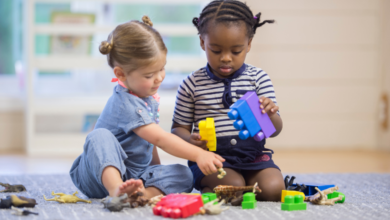Does Your Child Have An Imaginary Friend?
Brief Overview
Imaginary friends are a common and fascinating part of childhood, often emerging when children are between the ages of 2 and 7. While these invisible companions might seem puzzling or even concerning to some parents, they are typically a normal and healthy part of a child’s development. This article will explore why children create imaginary friends, the role these friends play in their lives, and how parents can best support their child’s imaginative play. We will also discuss when, if ever, it might be necessary to seek professional guidance.
Introduction
Imaginary friends have long been a subject of curiosity and intrigue. These fictional companions, often invisible to everyone except the child who creates them, can be as varied as the children themselves. Some are human, while others might be animals, fantastical creatures, or even inanimate objects brought to life by a child’s vivid imagination. For parents, discovering that their child has an imaginary friend can raise many questions: Is this normal? What does it mean? Should I be concerned? Understanding the purpose and benefits of imaginary friends can help parents navigate this unique aspect of their child’s development with confidence and ease.
The Role of Imaginary Friends in Childhood Development
- Emotional Expression and Coping Mechanism
- Understanding Emotions: Imaginary friends can serve as a safe outlet for children to express their emotions. Through interactions with their imaginary friends, children can explore a wide range of feelings, from joy and excitement to fear and sadness. This process helps them understand and manage their emotions in a controlled environment.
- Coping with Stress: Children often turn to their imaginary friends during times of stress or change, such as moving to a new home, starting school, or the arrival of a new sibling. These friends provide comfort and companionship, helping children cope with anxiety or uncertainty.
- Social Skills and Problem-Solving
- Practicing Social Interactions: Imaginary friends offer children a way to practice social skills and navigate relationships. Through pretend play, children learn about sharing, cooperation, and conflict resolution. They might have conversations, negotiate roles, or solve problems with their imaginary friends, all of which contribute to their social development.
- Exploring Different Perspectives: Interacting with an imaginary friend allows children to experiment with different roles and perspectives. They might switch between being the caregiver and the cared-for, the leader and the follower, or even take on the persona of their imaginary friend. This role-playing helps them understand the thoughts and feelings of others, enhancing their empathy and perspective-taking skills.
- Creativity and Imagination
- Fostering Creativity: Imaginary friends are a testament to a child’s creative abilities. Creating and maintaining an imaginary friend requires a high level of imagination, as children must construct personalities, stories, and scenarios for their friend. This imaginative play is crucial for cognitive development and fosters creativity, problem-solving, and innovative thinking.
- Storytelling and Language Development: Children often narrate elaborate stories involving their imaginary friends, which helps enhance their language and storytelling skills. They learn to structure narratives, use descriptive language, and develop a sense of plot and character development, all of which contribute to their cognitive growth.
Common Characteristics of Imaginary Friends
- Diverse Forms and Personalities
- Varied Identities: Imaginary friends can take on any form that a child’s imagination can conjure. They might be humans, animals, or fantastical beings. Some children even create multiple imaginary friends, each with distinct personalities, preferences, and roles in the child’s life.
- Dynamic Relationships: The relationship between a child and their imaginary friend can be dynamic, evolving over time. Imaginary friends might appear and disappear depending on the child’s needs or the context of their play. Some imaginary friends are constant companions, while others might only emerge in specific situations.
- Children’s Control Over the Imaginary Friend
- Control and Agency: One of the defining features of an imaginary friend is that the child has complete control over them. The child decides what the friend says, does, and feels. This control can be empowering for children, especially in a world where they often have little control over their surroundings or circumstances.
- Boundary Between Reality and Imagination: While children typically understand that their imaginary friend is not real, they can become deeply engrossed in the imaginary play. This blurring of reality and imagination is a normal part of childhood and does not indicate confusion about what is real and what is not.
Parental Concerns and How to Address Them
- Is It Normal for My Child to Have an Imaginary Friend?
- Prevalence: Research suggests that having an imaginary friend is a common experience for many children, with studies indicating that between 37% to 65% of children have had an imaginary friend at some point. This phenomenon is particularly common in children between the ages of 3 and 7.
- Normalcy: In most cases, imaginary friends are a normal and healthy part of development. They can even be a sign of creativity, advanced social skills, and emotional intelligence. However, it’s essential for parents to observe their child’s overall behavior and ensure that the imaginary friend is not interfering with their ability to engage with real-life peers or activities.
- When Should I Be Concerned?
- Signs of Concern: While imaginary friends are usually harmless, there are a few situations where parents might need to take a closer look. If a child is overly dependent on their imaginary friend to the exclusion of real-life interactions, if the imaginary friend is encouraging negative or harmful behaviors, or if the child seems unable to distinguish between fantasy and reality, it might be helpful to consult with a pediatrician or child psychologist.
- Behavioral Changes: Sudden changes in behavior, such as increased aggression, withdrawal, or anxiety, particularly if linked to the imaginary friend, could also warrant professional attention. It’s important to address any underlying issues that might be contributing to these changes.
- Encouraging Healthy Imaginative Play
- Supportive Environment: Parents can encourage healthy imaginative play by providing a supportive environment where creativity is nurtured. This includes offering a variety of toys, books, and activities that stimulate the imagination and allowing the child to lead their play with their imaginary friend.
- Balancing Fantasy and Reality: While it’s important to support a child’s imaginative play, it’s also crucial to help them navigate the boundary between fantasy and reality. Parents can do this by engaging in conversations about the differences between real and pretend and encouraging interactions with real-life friends and family members.
The Benefits of Imaginary Friends
- Emotional Benefits
- Comfort and Companionship: Imaginary friends can provide children with comfort and companionship, especially during times of loneliness or stress. They offer a non-judgmental friend who is always available, helping the child feel secure and understood.
- Emotional Expression: Through their interactions with imaginary friends, children can safely express emotions that they might find difficult to share with others. This can be particularly helpful for children who are shy or have difficulty verbalizing their feelings.
- Cognitive Benefits
- Enhanced Creativity: The process of creating and interacting with an imaginary friend stimulates cognitive development, particularly in the areas of creativity, problem-solving, and abstract thinking. It encourages children to think outside the box and explore new ideas.
- Language Development: Engaging in conversations with imaginary friends can also enhance a child’s language skills. They practice vocabulary, sentence structure, and storytelling, all of which contribute to their overall language development.
- Social Benefits
- Social Skills Practice: Imaginary friends offer a low-pressure way for children to practice social interactions. They learn about taking turns, sharing, and empathy, which can translate into improved social skills in real-life situations.
- Empathy and Perspective-Taking: By role-playing with their imaginary friends, children learn to understand and appreciate different perspectives. This helps build empathy and a deeper understanding of social dynamics.
Conclusion
Imaginary friends are a natural and often beneficial part of childhood development. They provide children with a creative outlet, a source of comfort, and a tool for exploring complex emotions and social interactions. While it’s important for parents to monitor their child’s behavior and ensure a healthy balance between imaginative play and real-life interactions, imaginary friends are typically nothing to worry about. Instead, they can be celebrated as a sign of a rich imagination and a valuable component of a child’s emotional and cognitive growth. By understanding the role of imaginary friends and supporting their child’s imaginative play, parents can help their child navigate this fascinating stage of development with confidence and joy.




